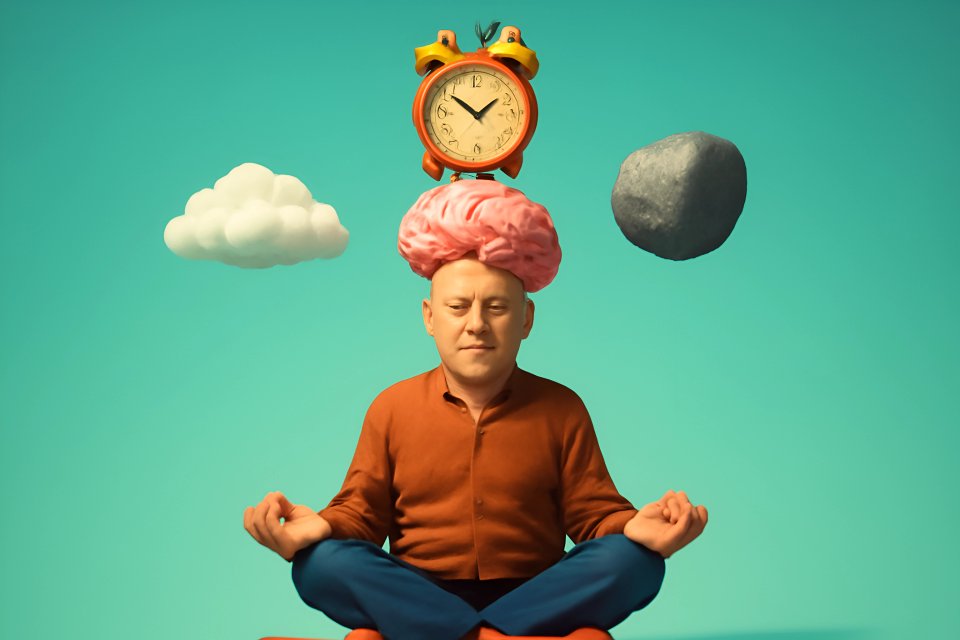
Does this sound familiar? You wake up, and before your feet even hit the floor, you already feel a day behind. The morning fog feels thicker than it used to, and that dreaded 3 PM wall doesn’t just slow you down—it stops you in your tracks. For too long, we’ve been told this is just a normal part of getting older. A non-negotiable decline in vitality that we simply have to accept.
But what if that’s a lie? What if the secret to reclaiming your energy, your focus, and your zest for life isn’t about pushing harder, but about getting smarter? The key isn't another cup of coffee or a sugary energy drink; it's a powerful, yet surprisingly gentle, tool you already possess: mindfulness. It’s about being more intentional with your day, from the moment you wake up until your head hits the pillow.
This isn't another list of impossible demands. This is your practical, step-by-step guide to building simple mindful daily routines for increased energy over 50. We will walk through the small, powerful shifts you can make in your morning, midday, and evening to build a rock-solid foundation for lasting vitality. Get ready to feel like yourself again.
Beyond Meditation: What "Mindful Habits for Older Adults" Really Means
When you hear the word "mindfulness," you might picture someone sitting cross-legged on a cushion for an hour, perfectly still. Let's throw that image out. For our purposes, mindfulness is simply the act of paying attention, on purpose, to the present moment without judgment. It’s about trading your autopilot mode for conscious awareness, listening to your body’s signals instead of bulldozing past them.
This simple shift from reacting to responding is your secret weapon for more energy. It’s not about adding more to your plate; it’s about getting more from what’s already there. By cultivating this awareness, you tap into a wellspring of benefits that directly combat the fatigue so many of us face after 50.
According to research highlighted by Harvard Health, mindfulness practices can physically change your brain and body's response to stress, which is a notorious energy thief. Instead of letting stress run the show, you take back control. Here’s how these mindful habits directly fuel your vitality:
- Reduces Energy-Draining Stress: Chronic stress keeps your body in a state of high alert, flooding it with the hormone cortisol. Mindfulness training has been shown to significantly lower cortisol levels, preserving the precious energy that stress would otherwise burn away.
- Improves Sleep Quality: Do you ever lie in bed with your mind racing? Mindfulness calms the nervous system, making it easier to fall asleep and stay asleep. The National Institute on Aging confirms that quality sleep is essential for cognitive function and physical restoration, making it the ultimate energy source.
- Promotes Better Choices: When you are truly present, you start to notice what your body is asking for. You’ll recognize the subtle cues for thirst before you’re dehydrated, or the need for a healthy snack before your blood sugar crashes. This intentional awareness helps you make healthier choices that prevent energy dips throughout the day.
Your Mindful Morning: A Gentle Start for All-Day Vitality
How you spend the first hour of your day sets the trajectory for the next sixteen. Do you launch into your day with a jolt of caffeine and a frantic scroll through emails and news alerts? Or do you give yourself a chance to start from a place of calm, grounded energy? A mindful morning isn't about adding complicated steps; it's about creating a gentle buffer between sleep and the demands of the world.
This routine is designed to be a quiet conversation with your body, waking it up slowly and intentionally. It’s a declaration that your well-being comes first. By dedicating just 15-20 minutes to these simple practices, you are making a direct investment in your all-day vitality.
You are building a foundation of calm and strength that will carry you through whatever the day throws your way. Forget the frantic rush. It's time to embrace a morning that serves you.
Step 1: Hydrate Before You Caffeinate
Before you even think about that first cup of coffee, reach for a glass of water. After a long night's sleep, your body is naturally dehydrated, and dehydration is a primary cause of fatigue and brain fog. That feeling of sluggishness might not be a need for caffeine, but a simple cry for water.
As recommended by health experts at the Mayo Clinic, starting your day with hydration is one of the easiest and most effective ways to wake up your metabolism and support your body's cellular functions. This simple act kickstarts your system and helps flush out toxins, setting a clean slate for the day.
Make it a ritual. Keep a glass of water on your nightstand so it’s the very first thing you see. Add a squeeze of lemon for a boost of vitamin C and flavor. This one small habit signals to your body that you are starting the day with care.
Step 2: Five Minutes of Gentle Movement
After hours of stillness, your joints can feel stiff and your muscles tight. Instead of forcing your body into action, ease into your day with five minutes of gentle, mindful movement. The goal here isn't a workout; it's a wake-up call for your circulatory system and a release for your joints.
The Cleveland Clinic notes that mindful movement improves circulation and flexibility, which is crucial for maintaining energy and mobility as we age. Focus on how your body feels with each stretch. Notice where you feel tightness and breathe into that space.
Try a few simple cat-cow stretches to warm up your spine, gentle neck rolls to release tension, or a few standing sun salutations to greet the day. For more specific guidance, a great next step is to explore a step-by-step home mobility routine to improve joint health, ensuring your movements are both safe and effective.
Step 3: A Moment of Mindful Stillness
Now that you’ve hydrated and moved your body, take just a few moments for stillness. In our hyper-connected world, we often jump straight from waking into doing, without ever checking in with ourselves. This is your chance to set a calm, focused intention for the day before the chaos begins.
This doesn't have to be formal meditation. It can be as simple as sitting by a window and taking three deep, conscious breaths. Feel the air fill your lungs and feel the release as you exhale. This practice helps reduce the tendency to ruminate on worries, a habit that research from UC Berkeley shows can drain mental energy.
You could also try writing down one thing you're grateful for in a journal or simply sipping your tea or coffee without any other distractions. The goal is to create a single moment of peace before you engage with your to-do list. This small pause grounds you in the present and sets a tone of calm control.
Step 4: Fuel with a Protein-Powered Breakfast
What you eat for your first meal has a massive impact on your energy for the rest of the day. Sugary cereals, pastries, or even just a cup of coffee on an empty stomach can send your blood sugar on a rollercoaster, leading to a sharp energy crash just a few hours later. The key to sustained morning energy is protein.
Protein and healthy fats digest more slowly, providing a steady release of fuel that keeps you feeling full, focused, and energized all morning long. This approach is backed by experts who stress the importance of a balanced breakfast for stable energy. A protein-rich meal prevents the highs and lows that leave you reaching for unhealthy snacks by mid-morning.
Swap the empty carbs for options like scrambled eggs with spinach, Greek yogurt topped with berries and nuts, or a smoothie blended with a scoop of protein powder. For more delicious and energizing ideas, be sure to check out these recipes for balanced breakfasts for seniors to start your day right.
Beat the Afternoon Slump: How to Recharge, Not Just Push Through
Ah, the dreaded afternoon slump. It arrives like clockwork between 2 and 3 PM, leaving you feeling foggy, irritable, and ready for a nap under your desk. The common response is to power through with more caffeine or sugar, but that only deepens the energy debt you’ll have to pay later. A mindful approach offers a better way: proactive recharges.
These midday pauses are not signs of weakness; they are strategic tools for maintaining your momentum. Think of them as pit stops in your day, allowing you to refuel your mind and body so you can finish the day strong. These are the energizing habits for seniors that separate those who thrive from those who just survive.
Instead of fighting against your body’s natural rhythm, you can learn to work with it. A few minutes of intentional rest and movement can make all the difference, turning that afternoon wall into a gentle wave of renewed focus.
The 10-Minute Mindful Walk
Getting up from your desk and moving is a great start, but a mindful walk takes it to the next level. This isn't about hitting a step count or burning calories. It's about engaging your senses and reconnecting with the world outside your head.
As you walk, bring your attention to the physical sensations of the moment. Feel your feet making contact with the ground. Notice the rhythm of your breath and the feeling of the air on your skin. Look around and truly see the colors of the leaves, the shape of the clouds, or the architecture of the buildings around you.
This practice of mindful awareness helps pull you out of the mental loops of your to-do list and into the restorative power of the present moment. It’s a mental reset that clears the fog and boosts creativity, leaving you feeling refreshed and ready to tackle the rest of your afternoon.
The "Tech-Free" Lunch Break
How often do you eat your lunch while scrolling through your phone, answering emails, or watching the news? When we eat distractedly, we barely register the food, which can lead to overeating and poor digestion—both of which contribute to post-meal lethargy. A tech-free lunch is a powerful act of mindfulness.
For just 15 or 20 minutes, put your devices away and give your full attention to your meal. Notice the colors, textures, and aromas of your food. Chew slowly and savor each bite, paying attention to the flavors and how your body feels as you eat.
This simple habit not only improves your digestion but also increases your sense of satisfaction from the meal, making you less likely to crave unhealthy snacks later. It transforms your lunch break from a simple refueling stop into a genuinely restorative and pleasurable experience.
The 15-Minute "Power Down"
Sometimes, the most productive thing you can do is nothing at all. When you feel your energy bottoming out, fighting it is futile. Instead, give yourself permission to power down with a short, intentional rest.
For some, a 15-20 minute power nap can work wonders for resetting the brain. For others who struggle with napping, a practice called Non-Sleep Deep Rest (NSDR) is a fantastic alternative. Simply lie down in a quiet space, close your eyes, and focus your attention on your breath or a guided body scan meditation.
The goal isn't necessarily to fall asleep, but to enter a state of deep relaxation that allows your nervous system to switch from "fight or flight" to "rest and digest." This brief period of profound rest can dramatically improve your alertness, mood, and cognitive function for the remainder of the day.
Winding Down Wisely: Your Evening Routine for Next-Day Energy
Your energy for tomorrow doesn't start when your alarm goes off. It begins with how you end your day today. A restorative evening routine is the first and most critical step in ensuring you get the deep, quality sleep your body and brain need to repair, recharge, and wake up feeling genuinely refreshed.
This isn't about adding more chores to your evening. It's about creating a clear transition away from the stress and stimulation of the day and into a state of calm and relaxation. These practices signal to your body and mind that it's time to wind down, making it easier to fall asleep and improve the overall quality of your rest.
Think of this as creating the perfect runway for a night of restorative sleep. By implementing a consistent daily routine for better energy in seniors, you are setting yourself up for a vibrant, energized tomorrow.
Create a "Digital Sunset"
One of the biggest culprits of poor sleep in our modern world is the bright blue light emitted from our screens—phones, tablets, computers, and TVs. This light suppresses the production of melatonin, the hormone that tells your body it's time to sleep. As the National Sleep Foundation explains, this can significantly disrupt your natural sleep-wake cycle.
Institute a firm rule for yourself: a "digital sunset." Turn off all screens at least 60-90 minutes before you plan to go to sleep. This gives your brain the time it needs to naturally start producing melatonin, making it much easier to feel sleepy.
Use this tech-free time to read a physical book, listen to calming music, talk with your partner, or engage in one of the other relaxing habits on this list. This single change can have a profound impact on how quickly you fall asleep and the quality of your rest.
A Gentle "Release the Day" Stretch
Throughout the day, we accumulate physical tension in our bodies, often in our neck, shoulders, and lower back. Going to bed with that tension can make it difficult to get comfortable and relax into deep sleep. A few minutes of gentle, mindful stretching can help release it.
The focus here is on slow, gentle release, not an intense workout. Try a simple child's pose to stretch your back, a seated forward fold to release your hamstrings, or gentle twists to ease spinal tension. As you stretch, breathe deeply and imagine the stress and tightness of the day melting away.
This practice not only helps your body physically relax but also serves as a mindful transition, helping you let go of the day's events. For more ideas, you can find mindful habits for better sleep in our detailed evening routines guide.
The "Brain Dump" Journal
Is your mind still racing with worries, to-do lists, and random thoughts when your head hits the pillow? A "brain dump" is a simple and incredibly effective technique to quiet this mental chatter. Keep a notebook by your bed and spend five minutes writing down everything that's on your mind.
Get it all out—the tasks for tomorrow, the conversation you're replaying, the anxieties that are bubbling up. The act of transferring these thoughts from your head onto paper can provide an immense sense of relief. It’s like telling your brain, "I've got this covered; you can rest now."
This practice is supported by sleep experts as a way to reduce pre-sleep anxiety and clear your mind for rest. It ensures that your bed is a sanctuary for sleep, not a stadium for mental gymnastics.
How to Build a Routine That Works For You
You’ve just read about a dozen new habits, and it might feel overwhelming. But please, do not try to implement all of these at once. The goal is to build a sustainable routine that feels supportive, not stressful. This is your personal energy blueprint, and you are the architect.
The key to making these habits stick is to approach them with the same mindfulness we've been discussing: with patience, flexibility, and self-compassion. According to the American Psychological Association, successful habit formation relies on starting small and being consistent, not perfect.
This is about progress, not perfection. You are building a new relationship with your energy and your body. Here’s how to make it last:
- Start Small: Choose just ONE new habit from this entire article that feels most appealing or achievable to you. Commit to practicing only that one habit for a full week.
- Be Flexible: Life happens. If you miss a day, don't throw in the towel. Simply pick it back up the next day without judgment. The goal is consistency over the long term.
- Listen to Your Body: Your energy needs will change from day to day. A mindful approach means adapting. Some days you might need a longer walk; other days, you might need a longer rest. Honor what your body is telling you.
- Anchor Habits: This is a powerful technique. Link your new habit to one you already do automatically. For example: "After I brush my teeth in the morning (
existing habit), I will do my five minutes of gentle stretching (new habit)."
Your Energy is Your Power
Thriving in your 50s, 60s, and beyond isn't about fighting a losing battle against time. It's about learning to work with your body, giving it the mindful attention and care it needs to operate at its best. The fatigue you’ve been feeling is not your destiny; it’s a signal that a new approach is needed.
By weaving these simple, mindful moments into your day—a gentle morning start, intentional midday pauses, and a restorative evening wind-down—you are not just managing fatigue. You are actively cultivating a deep, sustainable well of vitality. You are taking back control.
Your energy is your power. It’s the fuel for your passions, your relationships, and your joy. These mindful habits are a direct, daily investment in that power, ensuring you have the vitality to live your life to the absolute fullest.
What is one mindful habit you're excited to add to your day? Share your choice in the comments below—we’d love to cheer you on! For more tips on living your most vibrant life, explore our guide on Mindfulness and Meditation Techniques for Stress Relief Over 50.
















